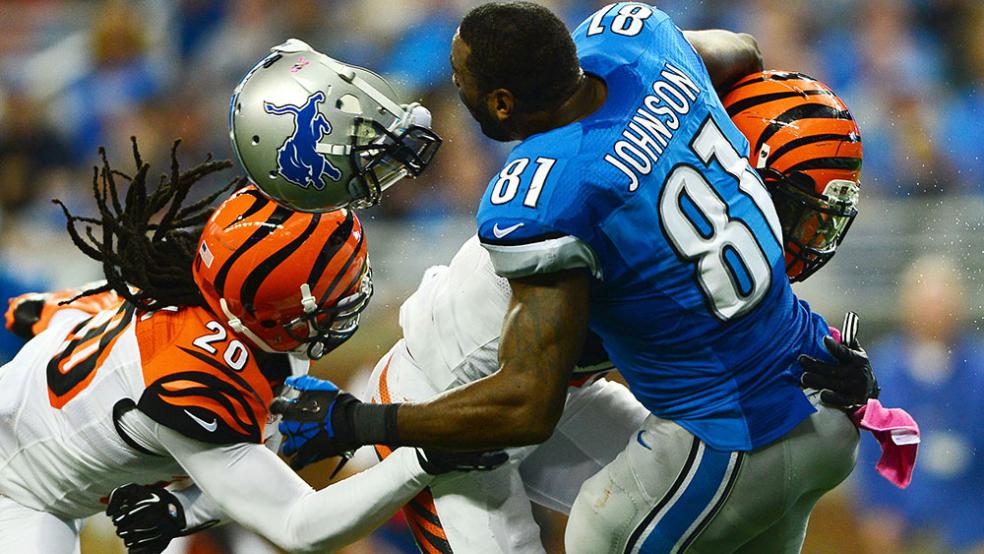The National Football League got its dream Super Bowl last weekend, when the Denver Broncos beat the New England Patriots and the Seattle Seahawks downed the San Francisco 49ers, matching the top two teams from each conference in next Sunday’s big game.
That game is indicative of how good things are going for the NFL right now. It generated revenue of more than $9 billion in 2012. It’s staging the first cold weather Super Bowl in the media capital of the world, New York and the game is dominating the news cycle a week before its set to be played. Commissioner Roger Goodell is well on his way to meeting his goal of $25 billion in annual revenue by 2027.
Related: Why High-Tech Helmets Won't Save the NFL
But there’s one stain on the NFL’s shield that even a gallon of Gatorade can’t wash away -- concussions. The NFL claims that it is attempting to make game safer for players by investing in new helmet technology and limiting hits to the head. But for years, the league publicly denied that a problem existed while privately holding evidence that head injuries sustained while playing football were contributing to the disability and deaths of former players.
Ahead of the Super Bowl, concerns over concussions in football have reached a fever pitch. President Obama recently told The New Yorker that he wouldn’t allow his son to play football, and likened players to smokers – both know the risks of their actions. Even Congress has weighed in on the issue in a series of hearings in 2009 and 2010.
The league likely thought it had settled the concussion issue once and for all when it agreed to a $760 million settlement with some 4,500 former players last year. However, last week, U.S. District Judge Anita Brody ruled that the settlement amount was simply not enough to pay for health care related to head injuries incurred while playing in the NFL.
“I am primarily concerned that not all retired NFL football players who ultimately receive a qualifying diagnosis, or their related claimants, will be paid,” she wrote in the ruling rejecting the settlement. “Even if only 10 percent of retired NFL football players eventually receive a qualifying diagnosis, it is difficult to see how the monetary award fund would have the funds available over its lifespan to pay all claimants at these significant award levels.”
Related: The NFL's Fantastic Finances: 14 Surprising Stats
Now lawyers for the league are scrambling to convince Brody that the settlement is fair, while lawyers for the players are submitting documentation that shows it’s not enough. Joseph Farelli, a labor law specialist and a partner in the New York law firm Pitta & Giblin, said he believes that NFL will end up paying more than 10 figures to settle the case.
“I wouldn’t be surprised if it hit $1 billion, even though that’s almost double the original amount,” he said. Brody “ was very skeptical whether the $760 million number was going to be sufficient to cover each and every claim.”
The NFL has refused to comment on the judge’s decision.
Health care and related costs
The concussions got attention when issues relating to head injuries felled big name players. The most notable is former San Diego Chargers linebacker Junior Seau, who committed suicide in 2012. It was later determined that he had suffered severe head trauma as a player.
Related: President Gets Stiff-Armed by NFL on Obamacare
But the vast majority of the class that filed suit against the NFL is players who have suffered, are suffering from, or will suffer from chronic health problems connected to head injuries. They weren’t stars, but journeymen who quietly accrued trauma over the course of their careers.
“The hard part is going to be estimating what the continued health care costs are going to be going forward,” Farelli said. “You’re not just talking about care -- a number of these patients are going to have 24 hour living assistance.”
It’s also unclear how quickly this will all be resolved. Farelli said in cases like this, attorneys for both sides would present evidence in the forms of actuarial data, health care studies, and reports from economists.
For example, head injuries are cumulative and start in high school, often during practices. If a high school player makes a college team, the injuries continue. If they get to the pros, they may be already damaged or extremely vulnerable to just one more hit.
However, because of the size of the class, no one attorney for the players is aware of what the judge has seen. Thomas Demetrio, an attorney for Dave Duerson, a former Chicago Bears defensive back who committed suicide and had head trauma, said he has no idea if these kinds of reports have even been done.
“Maybe they don't exist," he told ESPN. "Maybe they don't substantiate the $765 million figure."
Current players unprotected
Farelli said that whatever agreement is reached does not umbrella current players. If they do suffer problems connected to head trauma down the line, they can’t make the same claim as former players. They would have to prove the NFL knew more about head injuries then they’re disclosing to make the league responsible for chronic problems related to concussions.
“The current players couldn’t make that same claim. The NFL has acknowledged the danger of concussions,” he said. “The players are now aware of the dangers related to concussions. The NFL could argue that current players are assuming some of the risk. The lawsuit by the retired players is that they weren’t aware of the risks and the NFL was.”
Top Reads from the Fiscal Times:





